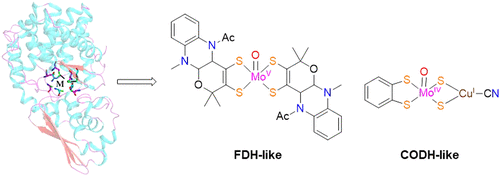当前位置:
X-MOL 学术
›
Acc. Chem. Res.
›
论文详情
Our official English website, www.x-mol.net, welcomes your feedback! (Note: you will need to create a separate account there.)
Carbon Dioxide Reduction: A Bioinspired Catalysis Approach
Accounts of Chemical Research ( IF 18.3 ) Pub Date : 2021-11-11 , DOI: 10.1021/acs.accounts.1c00461 Yun Li 1 , Maria Gomez-Mingot 1 , Thibault Fogeron 1 , Marc Fontecave 1
Accounts of Chemical Research ( IF 18.3 ) Pub Date : 2021-11-11 , DOI: 10.1021/acs.accounts.1c00461 Yun Li 1 , Maria Gomez-Mingot 1 , Thibault Fogeron 1 , Marc Fontecave 1
Affiliation

|
While developed in a number of directions, bioinspired catalysis has been explored only very recently for CO2 reduction, a challenging reaction of prime importance in the context of the energetic transition to be built up. This approach is particularly relevant because nature teaches us that CO2 reduction is possible, with low overpotentials, high rates, and large selectivity, and gives us unique clues to design and discover new interesting molecular catalysts. Indeed, on the basis of our relatively advanced understanding of the structures and mechanisms of the active sites of fascinating metalloenzymes such as formate dehydrogenases (FDHs) and CO dehydrogenases (CODHs), it is possible to design original, active, selective, and stable molecular catalysts using the bioinspired approach. These metalloenzymes use fascinating metal centers: in FDHs, a Mo(W) mononuclear ion is coordinated by four sulfur atoms provided by a specific organic ligand, molybdopterin (MPT), containing a pyranopterin heterocycle (composed of a pyran ring fused with a pterin unit) and two sulfhydryl groups for metal chelation; in CODHs, catalytic activity depends on either a unique nickel–iron–sulfur cluster or a dinuclear Mo–Cu complex in which the Mo ion is chelated by an MPT ligand. As a consequence, the novel class of catalysts, designed by bioinspiration, consists of mononuclear Mo, W, and Ni and as well as dinuclear Mo–Cu and Ni–Fe complexes in which the metal ions are coordinated by sulfur ligands, more specifically, dithiolene chelates mimicking the natural MPT cofactor. In general, their activity is evaluated in electrochemical systems (cyclic voltammetry and bulk electrolysis) or in photochemical systems (in the presence of a photosensitizer and a sacrificial electron donor) in solution. This research is multidisciplinary because it implies detailed biochemical, functional, and structural characterization of the inspiring enzymes together with synthetic organic and organometallic chemistry and molecular catalysis studies. The most important achievements in this direction, starting from the first report of a catalytically active biomimetic bis-dithiolene-Mo complex in 2015, are discussed in this Account, highlighting the challenging issues associated with synthesis of such sophisticated ligands and molecular catalysts as well as the complexity of reaction mechanisms. While the very first active biomimetic catalysts require further improvement, in terms of performance, they set the stage in which molecular chemistry and enzymology can synergistically cooperate for a better understanding of why nature has selected these sites and for developing highly active catalysts.
中文翻译:

二氧化碳减排:一种仿生催化方法
虽然在多个方向上发展,但最近才探索了仿生催化用于 CO 2还原,这是在要建立的能量转变的背景下最重要的具有挑战性的反应。这种方法特别重要,因为大自然告诉我们 CO 2还原是可能的,具有低过电位、高速率和大选择性,并为我们设计和发现新的有趣分子催化剂提供了独特的线索。事实上,基于我们对甲酸脱氢酶 (FDHs) 和 CO 脱氢酶 (CODHs) 等迷人金属酶的活性位点的结构和机制的相对先进的理解,有可能设计出原创的、活性的、选择性的和稳定的分子使用仿生方法的催化剂。这些金属酶使用迷人的金属中心:在 FDHs 中,Mo(W) 单核离子由特定有机配体钼蝶呤 (MPT) 提供的四个硫原子配位,钼蝶呤 (MPT) 含有吡喃蝶呤杂环(由与蝶呤单元融合的吡喃环组成) 和两个巯基用于金属螯合;在 CODH 中,催化活性取决于独特的镍-铁-硫簇或双核 Mo-Cu 络合物,其中 Mo 离子被 MPT 配体螯合。因此,由生物启发设计的新型催化剂由单核 Mo、W 和 Ni 以及双核 Mo-Cu 和 Ni-Fe 配合物组成,其中金属离子与硫配体配位,更具体地说,模拟天然 MPT 辅因子的二硫烯螯合物。通常,它们的活性在电化学系统(循环伏安法和体电解)或溶液中的光化学系统(存在光敏剂和牺牲电子供体)中进行评估。这项研究是多学科的,因为它意味着详细的生化、功能、启发性酶的结构表征以及合成有机和有机金属化学以及分子催化研究。在这个方向上最重要的成就,从 2015 年催化活性仿生双-二硫杂环戊烷-Mo 配合物的第一份报告开始,在本报告中进行了讨论,突出了与合成这种复杂的配体和分子催化剂相关的挑战性问题,以及反应机制的复杂性。虽然第一个活性仿生催化剂需要进一步改进,但在性能方面,它们为分子化学和酶学协同合作奠定了基础,以便更好地理解自然选择这些位点的原因并开发高活性催化剂。
更新日期:2021-12-07
中文翻译:

二氧化碳减排:一种仿生催化方法
虽然在多个方向上发展,但最近才探索了仿生催化用于 CO 2还原,这是在要建立的能量转变的背景下最重要的具有挑战性的反应。这种方法特别重要,因为大自然告诉我们 CO 2还原是可能的,具有低过电位、高速率和大选择性,并为我们设计和发现新的有趣分子催化剂提供了独特的线索。事实上,基于我们对甲酸脱氢酶 (FDHs) 和 CO 脱氢酶 (CODHs) 等迷人金属酶的活性位点的结构和机制的相对先进的理解,有可能设计出原创的、活性的、选择性的和稳定的分子使用仿生方法的催化剂。这些金属酶使用迷人的金属中心:在 FDHs 中,Mo(W) 单核离子由特定有机配体钼蝶呤 (MPT) 提供的四个硫原子配位,钼蝶呤 (MPT) 含有吡喃蝶呤杂环(由与蝶呤单元融合的吡喃环组成) 和两个巯基用于金属螯合;在 CODH 中,催化活性取决于独特的镍-铁-硫簇或双核 Mo-Cu 络合物,其中 Mo 离子被 MPT 配体螯合。因此,由生物启发设计的新型催化剂由单核 Mo、W 和 Ni 以及双核 Mo-Cu 和 Ni-Fe 配合物组成,其中金属离子与硫配体配位,更具体地说,模拟天然 MPT 辅因子的二硫烯螯合物。通常,它们的活性在电化学系统(循环伏安法和体电解)或溶液中的光化学系统(存在光敏剂和牺牲电子供体)中进行评估。这项研究是多学科的,因为它意味着详细的生化、功能、启发性酶的结构表征以及合成有机和有机金属化学以及分子催化研究。在这个方向上最重要的成就,从 2015 年催化活性仿生双-二硫杂环戊烷-Mo 配合物的第一份报告开始,在本报告中进行了讨论,突出了与合成这种复杂的配体和分子催化剂相关的挑战性问题,以及反应机制的复杂性。虽然第一个活性仿生催化剂需要进一步改进,但在性能方面,它们为分子化学和酶学协同合作奠定了基础,以便更好地理解自然选择这些位点的原因并开发高活性催化剂。



























 京公网安备 11010802027423号
京公网安备 11010802027423号